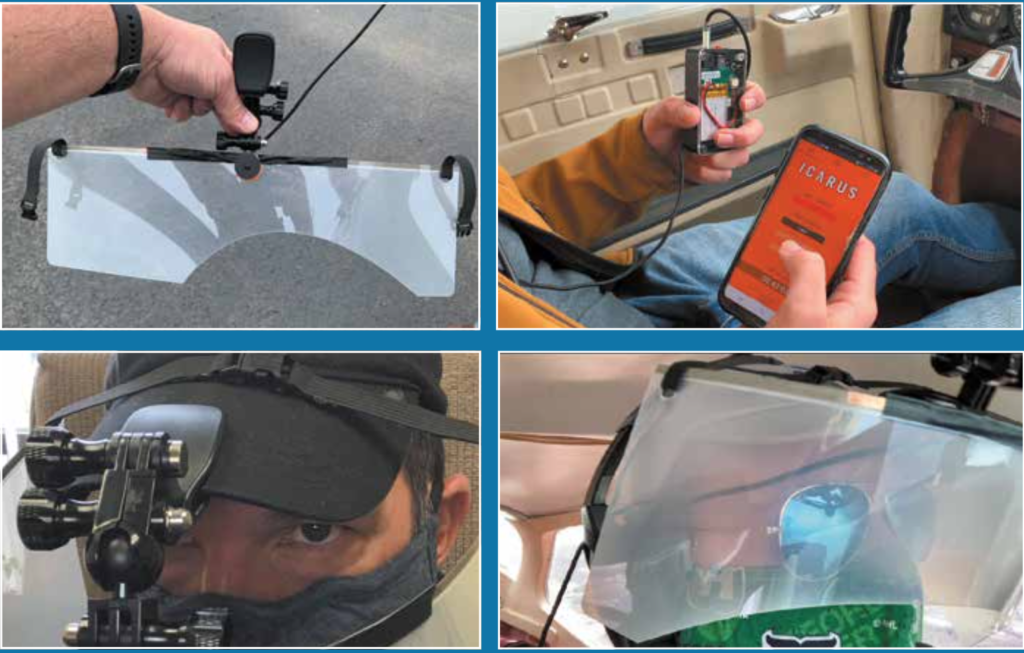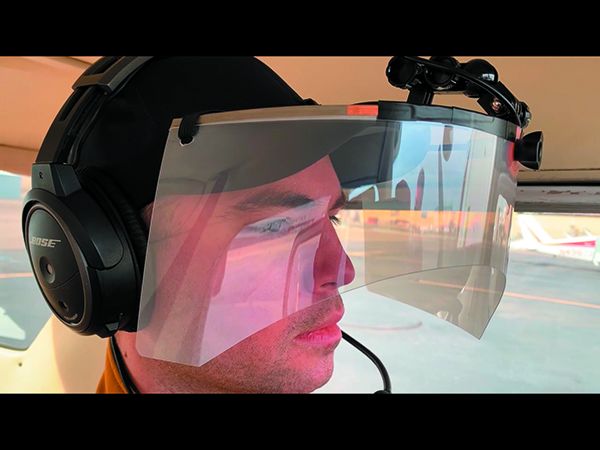In the flight training world, view-limiting devices (VLDs or hoods) haven’t changed much, and arguably most get the job done if you resist the temptation to sneak an occasional peak to the outside.
But Nick Sinopoli, a tech-savvy military helicopter pilot who lost a friend in an IMC wreck, believes the simple instrument hood can be better. He founded ICARUS Devices and he patented the smart VLD—a multi-piece system that allows the instructor to digitally control the view inside a see-through visor to more realistically simulate a trip through the clag. We took a look.
IMC HOOD ON STEROIDS
The device has been a work in progress since 2014, and the original design was more like electronic eyeglasses, or the familiar Foggles. That’s problematic for pilots who wear eyeglasses, although there are some eyeglasses-compatible traditional hoods. We rounded up IFR training hoods in the March 2019 issue of Aviation Consumer.
But the current ICARUS visor-like device uses a Polymer Dispersed Liquid Crystal (PDLC) film that changes imagery via an external battery-powered control module and a smartphone app for scenario-based IFR training.
The smartphone app enables the instructor to dial in the desired visibility, and there are basically four modes. The VMC Safety mode quickly changes the view to an unobstructed view through the visor, in the event you needed to quickly put your eyeballs out the windshield to spot traffic, for example. The other three modes control the simulated visibility.
There is a 1-mile mode, a 0.5-mile mode and no-visibility mode, simulating the forward visibility in solid IMC. Unlike a traditional VLD where it’s either zero-zero vis or clear and a million, the electronics that feed the ICARUS allow the instructor to change the transition—from gradually deteriorating visibility (clear to opaque) to sudden IMC, and also the gradual improvement of the visibility. One scenario is practicing the risky circle-to-land segment of an approach, where the instructor can tank the visibility on the hood as you fly the pattern. You know, the stuff that kills. The concept really is a more realistic way to simulate going in and out of the clag, and even with this first-gen system, the realism seems good.
For our demo in a Skyhawk on a VFR day, we brought along an active CFII—who actually felt sizable amounts of stress while shooting a busy ILS approach—while Sinopoli controlled the device with the app.

ROOM FOR IMPROVEMENTS
Technically speaking, we think this product is off to a good start, but more app interfacing can make it better. Sinopoli hinted at future third-party flight planning app interfacing. One potential feature is programming and flying a route in a tablet or smartphone, and the weather data shown on the app matches what the ICARUS wearer sees in the shield. Think of it as a wearable flight sim of sorts.
As for hardware, we think the action cam attachment hardware is rugged and allows for a good range of adjustment (we use the same hardware for mounting an action cam on a motorcycle helmet with excellent results). But that doesn’t necessarily make it ideal for use in aircraft, mainly for potential flail-zone impact issues in a crash—the hardware is close to the forehead. That said, the ICARUS is easy to use. We tried the visor with and without eyeglasses and there’s plenty of clearance and available adjustments to fine tune it.
“When I started this project, I just wanted to make a better instrument training hood, especially after fumbling while taking the hood on and off during my own IFR helicopter training,” Sinopoli said.
He makes the point that removing a traditional VLD at the decision height and flying the remainder of the segment visually out the window during a practice instrument approach destroys sizable amounts of training value. To that point, we think he’s succeeded with the hardware design of the current ICARUS smart VLD.
WHAT PRICE?
At press time, ICARUS was immersed in beta testing and was pre-ordering the product at $1000 for the fixed-wing version and $1500 for the helicopter model. Whether or not the typical Bonanza or Mooney owner will invest that money to supplement their training is unknown.
Our sense is that gadget freaks won’t resist the temptation to add it to the flight bag. Flight schools on a shoestring budget? Only time will tell. Visit www.icarusdevices.com and watch our flight trial video below.


